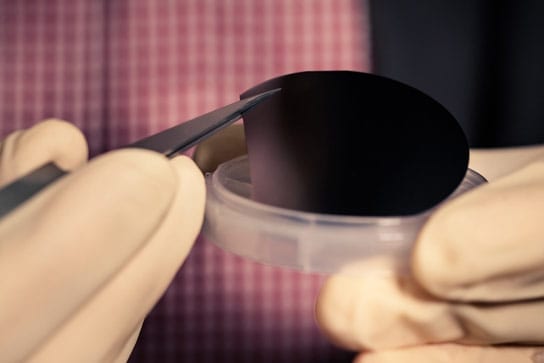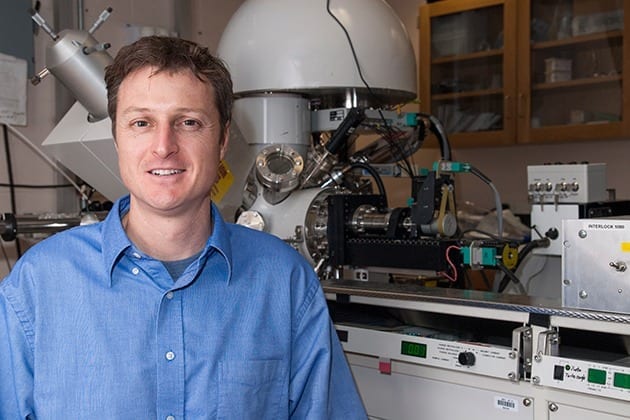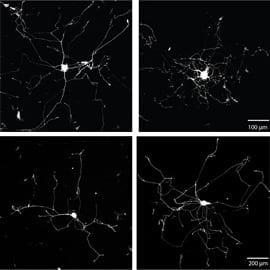
Based on the photon-enhanced thermionic emission (PETE) process, a new solar-energy device is about 100 times more efficient than its previous design.
Scientists working at the Stanford Institute for Materials and Energy Sciences (SIMES) have improved an innovative solar-energy device to be about 100 times more efficient than its previous design in converting the sun’s light and heat into electricity.
“This is a major step toward making practical devices based on our technique for harnessing both the light and heat energy provided by the sun,” said Nicholas Melosh, associate professor of materials science and engineering at Stanford and a researcher with SIMES, a joint SLAC/Stanford institute.
The new device is based on the photon-enhanced thermionic emission (PETE) process first demonstrated in 2010 by a group led by Melosh and SIMES colleague Zhi-Xun Shen, who is SLAC’s advisor for science and technology. In a report last week in Nature Communications, the group described how they improved the device’s efficiency from a few hundredths of a percent to nearly 2 percent, and said they expect to achieve at least another 10-fold gain in the future.
Conventional photovoltaic cells use a portion of the sun’s spectrum of wavelengths to generate electricity. But PETE uses a special semiconductor chip to make electricity by using the entire spectrum of sunlight, including wavelengths that generate heat. In fact, the efficiency of thermionic emission improves dramatically at high temperatures, so adding PETE to utility-scale concentrating solar power plants, such as multi-megawatt power tower and parabolic trough projects in California’s Mojave Desert, may increase their electrical output by 50 percent. Those systems use mirrors to focus sunlight into superbright, blazingly hot regions that boil water into steam, which then spins an electrical generator.
“When placed where the sunlight is focused, our PETE chips produce electricity directly; and the hotter it is, the more electricity it will make,” Melosh said.
The heart of the improved PETE chip is a sandwich of two semiconductor layers: One is optimized to absorb sunlight and create long-lived free electrons, while the other is designed to emit those electrons from the device so they can be collected as an electrical current. A cesium oxide coating on the second layer eases the electrons’ passage from the chip. Future research is aimed at making the device up to an additional 10 times more efficient by developing new coatings or surface treatments that will preserve the atomic arrangement of the second layer’s outer surface at the high temperatures it will encounter in the concentrating solar power plant.
“We expect that other materials, such as those incorporating barium or strontium, will make the surface much more stable up to at least 500 degrees Celsius,” said Jared Schwede, a Stanford graduate student who performed many of the PETE experiments. (play video to see Schwede explain the PETE technology)
The Latest Bing News on:
Solar Energy Device
- Solar Panel Pool Heaters: Do They Really Work?on May 9, 2024 at 12:15 pm
Solar panels continue to rise in popularity year after year as more people learn about the versatility of the renewable energy source. Yes, solar panels help save the environment and reduce people's ...
- Harnessing Sunlight Like Never Before: Hemispherical Solar Cells Unleash Unmatched Absorptionon May 9, 2024 at 4:17 am
New research suggests redesigning organic solar cells with a hemispherical shell structure to provide broader angular coverage, which is particularly beneficial for devices that need adaptable light ...
- New doping strategy increases lead-free perovskite solar cell efficiencyon May 9, 2024 at 12:00 am
An international research group has developed a solar cell based on a lead-free perovskite material known as Cs2AgBiBr6. The cell's absorber was doped with trans-polyacetylene, which reportedly helped ...
- High-school students light up UW-Oshkosh campus at Solar Olympicson May 8, 2024 at 12:01 pm
The students are from schools that participate in WPS' SolarWise for Schools program which provides renewable energy lessons.
- Tigo introduces power electronics supporting solar modules up to 800 Won May 8, 2024 at 11:16 am
The new MLPE from Tigo is designed to support commercial and industrial as well as utility-scale solar projects.
- A low-energy process for high-performance solar cells could simplify the manufacturing processon May 8, 2024 at 7:39 am
Finding reliable, eco-friendly power sources is crucial as our world grapples with increasing energy needs and the urgent call to combat climate change. Solar energy offers one solution, with ...
- DGIST identifies what causes electron-hole separation in thin-film solar cells to increase solar cell efficiencyon May 8, 2024 at 6:38 am
A joint research team between DGIST, Ewha Womans University, Incheon National University, and Sang-hoon Nam at MIT used atomic force microscopy to identify what causes electron-hole separation due to ...
- Tigo Energy Delivers Most Powerful Solar MLPE for High-Wattage and Bifacial Moduleson May 8, 2024 at 6:00 am
Tigo Energy, Inc. (NASDAQ: TYGO), a leading provider of intelligent solar and energy software solutions, today announced the newest additions to the Tigo Flex MLPE product family, the Tigo TS4-X line.
- Are solar panels worth it in Hawaii?on May 8, 2024 at 5:35 am
Hawaii has the highest average solar potential of any state, relatively low rooftop solar installation costs and generally solar-friendly policies. These and other factors make it the best state for ...
- Low-energy process for high-performance solar cellson May 7, 2024 at 3:50 pm
Finding reliable, eco-friendly power sources is crucial as our world grapples with increasing energy needs and the urgent call to combat climate change. Solar energy offers one solution, with ...
The Latest Google Headlines on:
Solar Energy Device
[google_news title=”” keyword=”Solar Energy Device” num_posts=”10″ blurb_length=”0″ show_thumb=”left”] [/vc_column_text]The Latest Bing News on:
Photon-enhanced thermionic emission
- Airborne single-photon lidar system achieves high-resolution 3D imagingon April 25, 2024 at 7:11 am
These pulses bounce off objects and are then captured by very sensitive detectors called single-photon avalanche diode (SPAD) arrays. These detectors provide enhanced sensitivity to single photons ...
- Spontaneous-emission control by photonic crystals and nanocavitieson February 19, 2024 at 9:55 am
According to quantum theory 6, SE occurs when an emitter relaxes from an excited state to its ground state by photon emission into ... was significantly enhanced. This result clearly demonstrates ...
- How to enable Enhanced Search Mode in Windows 11/10on December 31, 2023 at 3:34 pm
Microsoft has included an Enhanced Search Mode in Windows 11 and Windows 10. Compared to the Classic Mode, Enhanced search mode indexes everything on your Windows PC. In this post, we will share ...
- Technology Enhanced Teachingon November 21, 2023 at 7:10 pm
Academic Technology works with faculty to support their use of technology to enhance teaching and learning. Instructional Technology, Graphics, and Media Systems staff partner with faculty to design, ...
- Solar Thermal/Thermionic Energy Converterson August 8, 2023 at 6:08 pm
Libr. 1282 [4] Dominguez-Andrade, H, et al 2019, ‘Characterisation of thermionic emission current with a laser-heated system’. Review of Scientific Instruments, vol 90., pp. 045110 [5] EP/K030302/1 ...
- Emission spectraon July 25, 2020 at 9:11 pm
This means that each electron transition will produce a photon of a different frequency and hence a different colour. This causes line emission spectra to be produced, as shown below. This is not ...
- Versatile Tungsten Thermionic Emission SEM System - VEGA4on May 12, 2019 at 10:56 pm
Let us help you with your inquiries, brochures and pricing requirements Request A Quote Download PDF Copy Request A Quote Download PDF Copy Request A Quote Download ...
- Photon: Printing Revolutionon June 1, 2018 at 12:05 pm
The Quincy Patriot Ledger, with a circulation of 44,000, is the paper. The innovation is Photon--a process for setting type photographically, rather than through the use of any hot metal casting ...
The Latest Google Headlines on:
Photon-enhanced thermionic emission
[google_news title=”” keyword=”photon-enhanced thermionic emission” num_posts=”10″ blurb_length=”0″ show_thumb=”left”]










